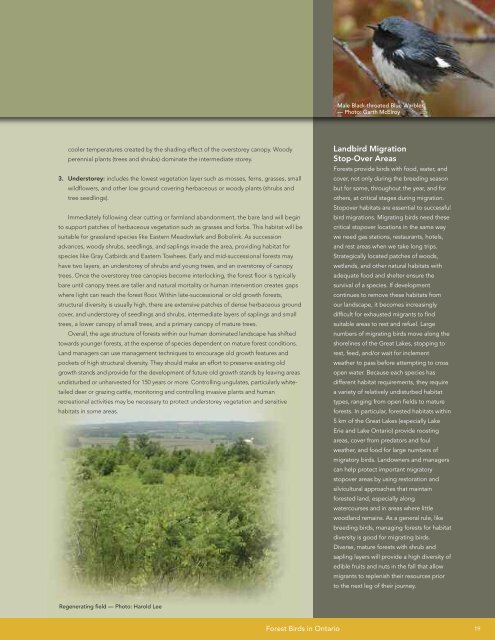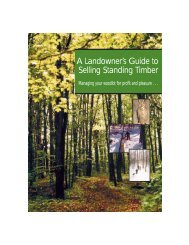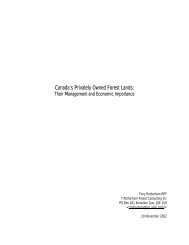A land manager's guide to conserving habitat for forest birds in ...
A land manager's guide to conserving habitat for forest birds in ...
A land manager's guide to conserving habitat for forest birds in ...
Create successful ePaper yourself
Turn your PDF publications into a flip-book with our unique Google optimized e-Paper software.
Male Black-throated Blue Warbler<br />
— Pho<strong>to</strong>: Garth McElroy<br />
cooler temperatures created by the shad<strong>in</strong>g effect of the overs<strong>to</strong>rey canopy. Woody<br />
perennial plants (trees and shrubs) dom<strong>in</strong>ate the <strong>in</strong>termediate s<strong>to</strong>rey.<br />
3. Unders<strong>to</strong>rey: <strong>in</strong>cludes the lowest vegetation layer such as mosses, ferns, grasses, small<br />
wildflowers, and other low ground cover<strong>in</strong>g herbaceous or woody plants (shrubs and<br />
tree seedl<strong>in</strong>gs).<br />
Immediately follow<strong>in</strong>g clear cutt<strong>in</strong>g or farm<strong>land</strong> abandonment, the bare <strong>land</strong> will beg<strong>in</strong><br />
<strong>to</strong> support patches of herbaceous vegetation such as grasses and <strong>for</strong>bs. This <strong>habitat</strong> will be<br />
suitable <strong>for</strong> grass<strong>land</strong> species like Eastern Meadowlark and Bobol<strong>in</strong>k. As succession<br />
advances, woody shrubs, seedl<strong>in</strong>gs, and sapl<strong>in</strong>gs <strong>in</strong>vade the area, provid<strong>in</strong>g <strong>habitat</strong> <strong>for</strong><br />
species like Gray Cat<strong>birds</strong> and Eastern Towhees. Early and mid-successional <strong>for</strong>ests may<br />
have two layers, an unders<strong>to</strong>rey of shrubs and young trees, and an overs<strong>to</strong>rey of canopy<br />
trees. Once the overs<strong>to</strong>rey tree canopies become <strong>in</strong>terlock<strong>in</strong>g, the <strong>for</strong>est floor is typically<br />
bare until canopy trees are taller and natural mortality or human <strong>in</strong>tervention creates gaps<br />
where light can reach the <strong>for</strong>est floor. With<strong>in</strong> late-successional or old growth <strong>for</strong>ests,<br />
structural diversity is usually high, there are extensive patches of dense herbaceous ground<br />
cover, and unders<strong>to</strong>rey of seedl<strong>in</strong>gs and shrubs, <strong>in</strong>termediate layers of sapl<strong>in</strong>gs and small<br />
trees, a lower canopy of small trees, and a primary canopy of mature trees.<br />
Overall, the age structure of <strong>for</strong>ests with<strong>in</strong> our human dom<strong>in</strong>ated <strong>land</strong>scape has shifted<br />
<strong>to</strong>wards younger <strong>for</strong>ests, at the expense of species dependent on mature <strong>for</strong>est conditions.<br />
Land managers can use management techniques <strong>to</strong> encourage old growth features and<br />
pockets of high structural diversity. They should make an ef<strong>for</strong>t <strong>to</strong> preserve exist<strong>in</strong>g old<br />
growth stands and provide <strong>for</strong> the development of future old growth stands by leav<strong>in</strong>g areas<br />
undisturbed or unharvested <strong>for</strong> 150 years or more. Controll<strong>in</strong>g ungulates, particularly whitetailed<br />
deer or graz<strong>in</strong>g cattle, moni<strong>to</strong>r<strong>in</strong>g and controll<strong>in</strong>g <strong>in</strong>vasive plants and human<br />
recreational activities may be necessary <strong>to</strong> protect unders<strong>to</strong>rey vegetation and sensitive<br />
<strong>habitat</strong>s <strong>in</strong> some areas.<br />
Landbird Migration<br />
S<strong>to</strong>p-Over Areas<br />
Forests provide <strong>birds</strong> with food, water, and<br />
cover, not only dur<strong>in</strong>g the breed<strong>in</strong>g season<br />
but <strong>for</strong> some, throughout the year, and <strong>for</strong><br />
others, at critical stages dur<strong>in</strong>g migration.<br />
S<strong>to</strong>pover <strong>habitat</strong>s are essential <strong>to</strong> successful<br />
bird migrations. Migrat<strong>in</strong>g <strong>birds</strong> need these<br />
critical s<strong>to</strong>pover locations <strong>in</strong> the same way<br />
we need gas stations, restaurants, hotels,<br />
and rest areas when we take long trips.<br />
Strategically located patches of woods,<br />
wet<strong>land</strong>s, and other natural <strong>habitat</strong>s with<br />
adequate food and shelter ensure the<br />
survival of a species. If development<br />
cont<strong>in</strong>ues <strong>to</strong> remove these <strong>habitat</strong>s from<br />
our <strong>land</strong>scape, it becomes <strong>in</strong>creas<strong>in</strong>gly<br />
difficult <strong>for</strong> exhausted migrants <strong>to</strong> f<strong>in</strong>d<br />
suitable areas <strong>to</strong> rest and refuel. Large<br />
numbers of migrat<strong>in</strong>g <strong>birds</strong> move along the<br />
shorel<strong>in</strong>es of the Great Lakes, s<strong>to</strong>pp<strong>in</strong>g <strong>to</strong><br />
rest, feed, and/or wait <strong>for</strong> <strong>in</strong>clement<br />
weather <strong>to</strong> pass be<strong>for</strong>e attempt<strong>in</strong>g <strong>to</strong> cross<br />
open water. Because each species has<br />
different <strong>habitat</strong> requirements, they require<br />
a variety of relatively undisturbed <strong>habitat</strong><br />
types, rang<strong>in</strong>g from open fields <strong>to</strong> mature<br />
<strong>for</strong>ests. In particular, <strong>for</strong>ested <strong>habitat</strong>s with<strong>in</strong><br />
5 km of the Great Lakes (especially Lake<br />
Erie and Lake Ontario) provide roost<strong>in</strong>g<br />
areas, cover from preda<strong>to</strong>rs and foul<br />
weather, and food <strong>for</strong> large numbers of<br />
migra<strong>to</strong>ry <strong>birds</strong>. Landowners and managers<br />
can help protect important migra<strong>to</strong>ry<br />
s<strong>to</strong>pover areas by us<strong>in</strong>g res<strong>to</strong>ration and<br />
silvicultural approaches that ma<strong>in</strong>ta<strong>in</strong><br />
<strong>for</strong>ested <strong>land</strong>, especially along<br />
watercourses and <strong>in</strong> areas where little<br />
wood<strong>land</strong> rema<strong>in</strong>s. As a general rule, like<br />
breed<strong>in</strong>g <strong>birds</strong>, manag<strong>in</strong>g <strong>for</strong>ests <strong>for</strong> <strong>habitat</strong><br />
diversity is good <strong>for</strong> migrat<strong>in</strong>g <strong>birds</strong>.<br />
Diverse, mature <strong>for</strong>ests with shrub and<br />
sapl<strong>in</strong>g layers will provide a high diversity of<br />
edible fruits and nuts <strong>in</strong> the fall that allow<br />
migrants <strong>to</strong> replenish their resources prior<br />
<strong>to</strong> the next leg of their journey.<br />
Regenerat<strong>in</strong>g field — Pho<strong>to</strong>: Harold Lee<br />
Forest Birds <strong>in</strong> Ontario 19

















